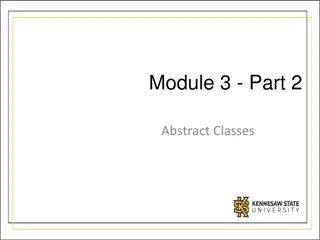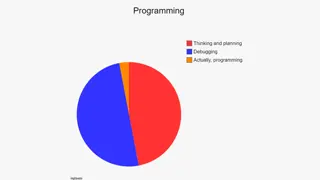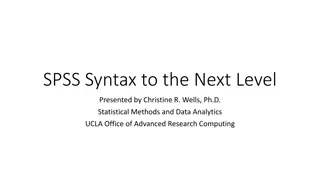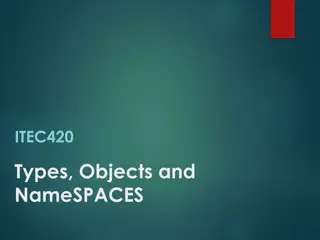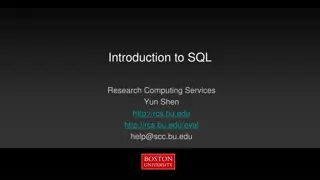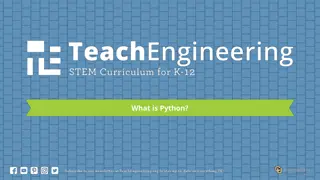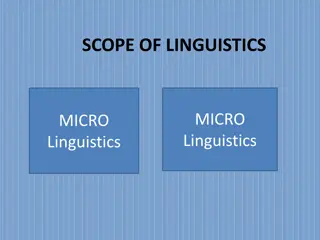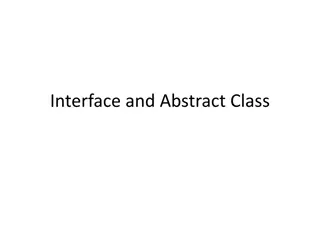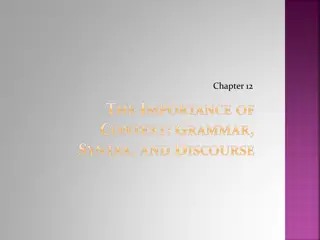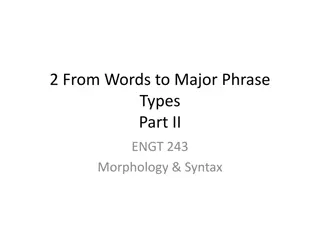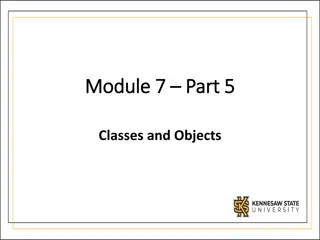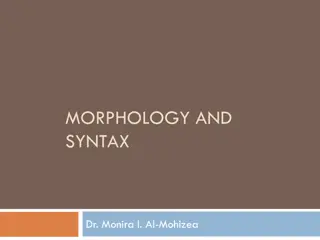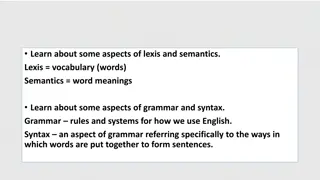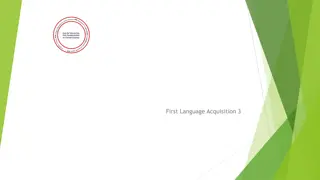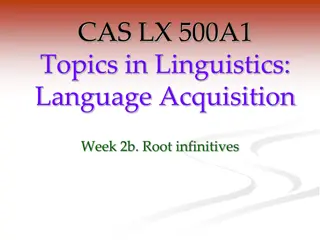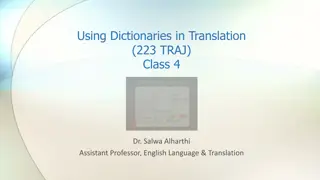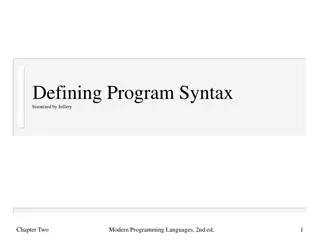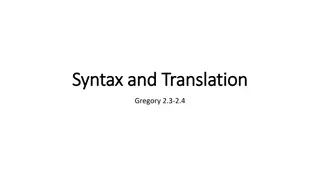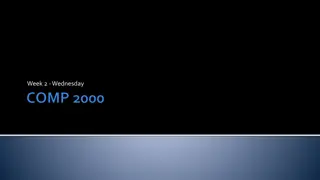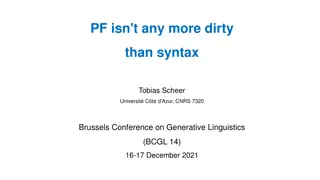Syntax and Word Classes
Delve into the world of syntax and word classes with a focus on morphology and structure. Understand the arrangement of elements in language statements and the importance of nouns, adjectives, verbs, and adverbs in conveying information. Explore the derivational morphology of NAVA words and their role in forming sentences.
Download Presentation

Please find below an Image/Link to download the presentation.
The content on the website is provided AS IS for your information and personal use only. It may not be sold, licensed, or shared on other websites without obtaining consent from the author.If you encounter any issues during the download, it is possible that the publisher has removed the file from their server.
You are allowed to download the files provided on this website for personal or commercial use, subject to the condition that they are used lawfully. All files are the property of their respective owners.
The content on the website is provided AS IS for your information and personal use only. It may not be sold, licensed, or shared on other websites without obtaining consent from the author.
E N D
Presentation Transcript
+ Morphology & Syntax Dr. Monira Al-Mohizea
+Introduction to syntax What is SYNTAX? Grammar: Words (and Phrases) Introducing word class Problems in definitions of word classes
+What is Syntax?? Definition: The word syntax derives from the Greek word syntaxis, which means arrangement. Morphology deals with word formation out of morphemes; syntax deals with phrase and sentence formation out of words. Syntax is the grammar, structure, or order of the elements in a language statement.
+Word class Any piece of language, written text or a spoken piece of dialogue, consists of words. But.. how many kinds of words are there? What do words make up? DISCUSS??
+ There are 11 word classes commonly known as 'parts of speech ). 'word-chunks form larger units phrases syntax matters. We will now consider 4 of the 11 word classes, nouns, adjectives, verbs and adverbs (NAVA) words.
+NAVA content words Consider the following: Word classes Examples Noun girl, water, beauty Adjective good, watery, calm Verb (full verb) sing, walk, become Adverb now, safely, here
+Answers Word classes Examples Noun girl, water, beauty Adjective good, watery, calm Verb (full verb) sing, walk, become Adverb now, safely,here
+ Importance of NAVA words (1) we add one word from each of the four classes to make a sentence, we get a clear picture of something going on in the real world, with each word making its own contribution to that picture. They are crucial to convey information (e.g. when E.g. Young ( ?) cheetahs ( ?) mature (? ) quickly (? ) This is why words of these classes are often called 'content words'.
+ Importance of NAVA words (2) can form nouns, adjectives, verbs and adverbs by adding suffixes, e.g., teach+er, wonder+ful, class+ify, sober+ly. NAVA words have derivational morphology: We These classes have a large number of members: English has thousands of nouns, verbs, adjectives and adverbs. In comparison to this, other word classes have a very small membership, of 50 or less.
+In real life- experiment English has thousands of nouns, verbs, adjectives and adverbs. In comparison to this, other word classes have a very small proportion, of 50 or less. Any Dictionary of English would include almost near 100% are NAVA words as headwords. Now, take a random paragraph or two of a text, e.g. a novel, and count the number of running words that are NAVA words, and the number that are not, what do you find ? (corpus??) about 35 % to 60 % of the words are ???? words.
+Conclusion.. The conclusion we can draw is that words which are not NAVA words, although small in number, tend to occur more frequently. Words like the, of, it, and tend to appear on almost every line of text, whereas words such as, young, cheetahs, mature and quickly occur much more rarely. The 'non-content' words are called function words, because their usefulness does not lie in the information content they convey, but in signaling grammatical function and grammatical structure. The other seven word classes, apart from the content are: ???
+Consider and label the following: Word classes Examples Determiner Auxiliary (verb) can, will, may, be, do Pronoun Numeral* one, two, 15, fifth, 10th Preposition Discourse Conjunction Marker* gee, right, heck, wow the, a, this, some, all 1, she, all, him, anyone of, in, on, at, horn, to, as oh, well, yes, okay, and, or, but if, when, as
+'Function word' classes Word classes Examples Determiner the, a, this, some, all Auxiliary (verb) Pronoun 1, she, all, him, anyone Numeral* one, two, 15, fifth, 10th Preposition of, in, on, at, horn, to, as Discourse markers Conjunction and, or, but if, when, as Marker* gee, right, heck, wow can, will, may, be, do oh, well, yes, okay, *In some ways numerals and discourse markers are like content classes, but for now we place them among the function classes.
+Consider the following sentences: Make a list, in four columns, of the italicized words which are : (i) nouns, (ii) adjectives, (iii) verbs, and (iv) Adverbs, ignoring other words 1. New cars are very expensive nowadays. 2. I understand that even Dracula hates werewolves. 3. I have won more rounds of Golf than you have had hot dinners. Mention the reason behind your classification, and think about a definition of each word class:
+NAVA Content words A noun is a naming word: it refers to a thing, person, substance, etc. An adjective is a word that describes something about a noun: it denotes a quality. A verb is a doing word: it refers to an action. An adverb is a word that says something about other types of words, such as verbs, adjectives and adverbs. Such definitions are largely semantic, i.e. they rely on properties related to meaning of the word.
+Problems of semantic definitions (1) They are problematic because: (1) they are sometime vague and (2) they maybe wrong, e.g. I have won more rounds of Golf than you have had hot dinners. Most typical members of the class of nouns are words as Karen, chairs, dogs => i.e, referring to people , animal, things, or substance that we can see and touch. Anything that we can see and touch are called concert nouns
+Problems of semantic definitions (2) The verb definition as doing word applies to went looked, and won, but not easily to are, hate and understand. The definition can be improved if we specify that it denotes states and actions. However, difficulty still applies as these words are also vague E.g. the girls seemed hungry. What does seem here refer to? Hungry fits state word more than seem . This definition fails to keep word classes apart. ??
+Conclusion Compare the following: hates in Dracula hates werewolves with hatred in Dracula's hatred of werewolves What can you conclude?
+Defining word classes: form, function & meaning We can not just rely on meaning when recognizing word classes. Therefore, instead of only relying on a single-line definition . E.g. 'a verb is a doing word', it is best to consider the definition of a word class combining three elements: form, function and meaning.
+(1) Form We can tell the class of a word partly from its form, made up of (1) stems and (2) affixes: Derivational suffixes are characteristic of certain word classes: e.g., electric-ity (N); electr-ify (V); electric-al (ADJ). Inflectional suffixes can be added to change the form of a word: E.g. box => box-es (N); work => work-ed (V); tall => tall-er (ADJ). These grammatical endings can be simply called inflections, and compared to some European languages (e.g., German), English has only a few of them. In some cases, English words have inflections which involve change in the form of a word, (e.g. a change of vowel, man => men), or a complete change in the word (e.g. go => went).
+(2) Function We can tell the class of a word by the way it occurs in certain positions or structural contexts. i.e., words have certain functions or roles in the structure of a sentence. E.g. Consider the following: The cook (?) does not actually cook (?) the meal. How can we differentiate between cook Obviously there is no clear difference of form to help us, so it most be the position of the word in relation to other words that tells us its class, i.e. context.
+(3) Meaning Meaning is a less reliable criterion as discussed, but it is not entirely useless. Recognizing certain semantic types of word (i.e., word types classified according to their meaning), such as action verbs, state verbs, abstract nouns, etc., as it can help to check the purely structural criteria (those of form and function).
+Definitions In English there are verbs that are not normally used in the Continuous Tense, because they describe state rather than an action. They are called state verb (or non-progressive verbs). E.g. like, love, hate, prefer, remember, forget, believe, etc. The verbs that can be used in the Continuous Tense are called action verbs (or dynamic verbs). E.g. read. N.B. a few verbs can be both state and action verbs depending on their meaning. I think you made a mistake. (think = believe ) VS. I am thinking about my mum now. (think = mental process). An abstract noun refers to something with which a person cannot physically interact (e.g. love). A concrete noun is a person, place or thing (e.g. Mohammad, Riyadh, chair).
+ Thank You..


